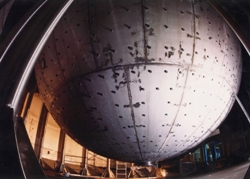
Ian Randall* reports from the Borexino Collaboration, which has discovered that the deep Earth is an unexpected source of anti-neutrinos.
Geoscientist Online 12 August 2010
It is one of geology’s remaining fundamental questions – exactly what drives the immense power house found deep within the Earth’s interior? The serendipitous discovery of subatomic particles – called geoneutrinos - emanating from deep beneath our feet may hold the key to solving this puzzle.
When cosmic and solar radiation collides with atoms they emit particles called neutrinos – fundamental particles with no charge, almost no mass travelling close to the speed of light. They can pass through regular matter uninterrupted, making them nearly impossible to detect.
At the Gran Sasso National Laboratory in Italy, however, an international team of scientists working on the Borexino Collaboration have created a “neutrino telescope” – a 10m-diameter steel sphere, designed to detect the rare interactions of passing neutrinos. Within this device, one thousand tons of nylon-encased hydrocarbon scintillator is continuously watched over by a vast array of super-sensitive photodetectors for the faintest signs of matter interaction.
The Borexino project focuses on the elimination of background radiation – aiming to reduce the vast noise that would overwhelm the detection of neutrino signals. To this end, the detector itself was built almost a mile below ground – but the scientists did not originally imagine that the Earth itself might turn out to be a source of the rare particles they were seeking.
"As we were building the experiment, we realized we had the capability of detecting particles that were coming at us from the radioactivity deep inside the Earth," says Cristiano Galbiati, one of the physicists involved in the research.
The neutrinos from within the Earth’s crust are actually anti-neutrinos – antimatter equivalents of regular neutrinos, which are believed to form as a by-product of the radioactive decay of potassium, thorium and uranium, around 1800 miles beneath our feet.
The researchers are able to distinguish between the two types of particle by their unique signals recorded in their detector. While geoneutrinos were first observed in Japan in 2005, the rarity of their observation has made them difficult to study – but with two years’ data gathered so far, the Borexino experiment will help to shine more light on their origins.
"This is an important result" says Frank Calaprice, one of the authors of this study, published in the April issue of Physics Letters B. "It shows that geoneutrinos have been detected and firmly establishes a new tool to study the interior of the Earth."
It is hoped that analysis of geoneutrino emissions might provide a greater understanding of the decay reactions that drive mantle convection – with the possibility of one day being able to map out mantle flow, helping towards better predictions of volcanic and tectonic episodes.
It was not previously known whether radioactive decay within the crust was the primary agent in heating the surrounding rock, or merely one of a number of factors involved – but, as Calaprice explains, with the definite detection of geoneutrinos at the Borexino facility, we can now be certain that decay does contribute almost all of the energy in play.
Thomas Duffy, professor of geosciences at Princeton University, says: "It's a very significant discovery and holds much promise for better understanding the composition of the Earth and how the Earth operates."
*Ian Randall has recently graduated in Science Journalism from City University and is working as an intern on Geoscientist.